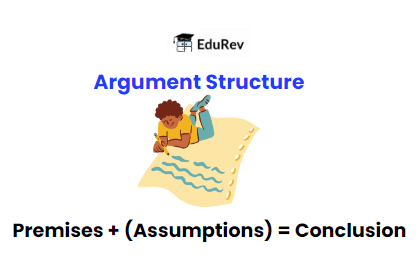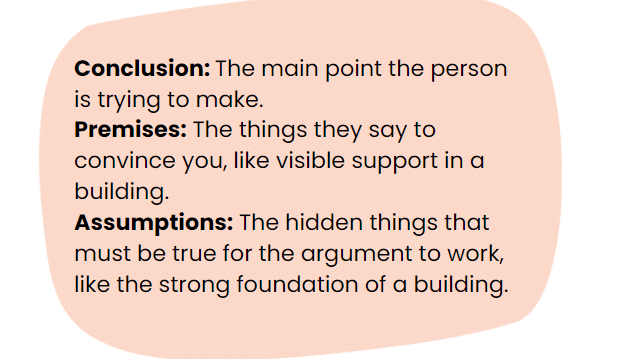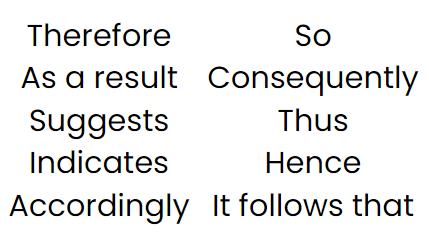Argument Structure for GMAT | Verbal for GMAT PDF Download
| Table of contents |

|
| Understanding GMAT Critical Reasoning Arguments |

|
| Understanding an Argument |

|
| Understanding the Conclusion in an Argument |

|
| Common Signal Words for Argument Parts |

|
| Solved Questions |

|
Critical Reasoning questions on the GMAT involve reading brief arguments (each argument is generally one to three sentences long) and answering questions relating to those arguments.
In order to analyze GMAT arguments, it is important to understand their basic structure:

Think of an argument like a building. At the top of the building is the "Conclusion" – it's the main idea or opinion the person is trying to convince you of.
Understanding GMAT Critical Reasoning Arguments
Building Blocks:Now, to support this conclusion, we have two types of building blocks – "Premises" and "Assumptions."
Premises are like Facts or Support:
These are the things the person says that help back up their main point.
They can be facts, opinions, or claims that try to convince you.
It's like the visible part of the building, the walls and floors – you can see them; they're the support you can easily identify.
Assumptions are the Hidden Foundation:
These are the things that the person doesn't say directly but needs to be true for their argument to make sense.
It's like the strong foundation underground that you can't see but is crucial to keeping the building standing.
Putting it Together:
So, in an argument, the conclusion is like the roof of the building, and the premises are like the walls and floors that you can see. The assumptions are like the strong foundation hidden below that you can't see but are essential for the building (or argument) to stand tall.

Understanding an Argument
Consider the following argument:
Studying regularly is one factor that has been shown to improve one's performance on the GMAT. Melissa took the GMAT and scored a 500. If she studies several times a week, Melissa can expect to improve her score.
- First look for the conclusion, which is the main point of the argument. The conclusion is often the last sentence of an argument, but not always. Sometimes the conclusion appears as the first sentence.
- The main point of this argument is the last sentence: If she studies several times a week, Melissa can expect to improve her score. After finding the conclusion, look for the premises that lead to the conclusion.
- Premises include all the pieces of information written in the argument. Premises provide evidence that usually supports, or leads to, the conclusion.
- Premise: Studying regularly is one factor that has been shown to improve one's performance on the GMAT.
Premise: Melissa took the GMAT and scored a 500. - Often, all you will need to find are the conclusion and the premises.
- Assumptions are unstated parts of the argument. Therefore, you will never find an assumption stated in an argument. However, assumptions are necessary to reach the given conclusion.
For example, one assumption in this argument is that studying several times a week qualifies as studying regularly.
Strategy Tips:
- Look for the conclusion, often at the beginning or end.
- Identify premises, the supporting info.
- Assume there are hidden parts (assumptions).
- Pay attention to signal words indicating the conclusion.
Understanding the Conclusion in an Argument
Imagine a friend excitedly telling you about a new movie. They mention it's based on a novel by a famous author, and Salman Khan is the main actor. Then they confidently say, "I'm sure this movie is going to be a super hit."
1. Conclusion Explained:
The conclusion is like the main idea or opinion the person is trying to convince you of.In this case, it's the confident statement that the movie will be a super hit.It's what your friend is trying to prove based on the given facts about the movie.
2. Identifying the Conclusion:
To find the conclusion, you look for words indicating an opinion, judgment, or prediction.In this example, the phrase "I'm sure this movie is going to be a super hit" is the conclusion.It's what your friend is trying to prove or convince you of based on the details shared.
3. Strategy to Spot the Conclusion:
- Ask yourself: "What is the author or speaker trying to prove?"
- Watch out for words signaling an opinion or conclusion, like "believe that," "conclude that," or "it follows that."
- Look for conjunctions like "therefore," "thus," "consequently," or "hence" – these often precede the conclusion.
4. Another Example:
If someone says, "Company XYZ has suffered huge losses this quarter; therefore, they should do a thorough analysis of their strategies."
The conclusion here is the recommendation: "they should do a thorough analysis of their strategies."
In Simple Words:
Conclusion: The main point or opinion someone is trying to prove.
Identifying the Conclusion: Look for words indicating a strong belief or recommendation.
Strategy: Pay attention to phrases like "I believe that," "therefore," or "it follows that." They often precede the conclusion.
Common Signal Words for Argument Parts
As we discussed earlier, the conclusion of an argument is often preceded by certain signal words. You should be on the lookout for these conclusion Signals:
 Conclusions can also be signalled by their strong tone, often marked by "opinion" wordssuch as should ("This law should be enacted ... ").Likewise, certain other words signal premises. Here ate the most common premise signals:
Conclusions can also be signalled by their strong tone, often marked by "opinion" wordssuch as should ("This law should be enacted ... ").Likewise, certain other words signal premises. Here ate the most common premise signals:
- Since
- Due to
- As a result of
- Because
- Given that
- As
Solved Questions
Question 1:
Argument:
Studying regularly is one factor that has been shown to improve one's performance on the GMAT. Melissa took the GMAT and scored a 500. If she studies several times a week, Melissa can expect to improve her score.
What is the conclusion of the argument?
Solution:
Conclusion: If Melissa studies several times a week, she can expect to improve her score.
This is the main point the argument is trying to prove based on the given premises (that studying regularly improves performance and Melissa's score).
Question 2:
Argument:
The government has announced that the country will achieve carbon neutrality by 2030. Experts claim that this goal is unrealistic because the country lacks the necessary infrastructure and technology to support such rapid changes. However, the government's stance is that it is committed to reducing emissions and will push forward with their plans regardless of these challenges.
What is the conclusion of the argument?
Solution:
Conclusion: The government is committed to reducing emissions and will push forward with their plans regardless of challenges.
This is the main point that the government is asserting, which is the conclusion of the argument, supported by the mention of challenges.
Question 3:
Argument:
More exercise is associated with better mental health outcomes. A recent study found that people who exercised regularly reported lower levels of stress and anxiety. Additionally, these individuals showed improvements in their sleep quality. Therefore, incorporating regular physical activity into one's lifestyle can significantly benefit mental well-being.
What are the premises in this argument?
Solution:
Premises:
More exercise is associated with better mental health outcomes.
A recent study found that people who exercised regularly reported lower levels of stress and anxiety.
These individuals showed improvements in their sleep quality.
These are the facts or evidence that support the conclusion that exercise can significantly benefit mental well-being.
Question 4:
Argument:
A study found that people who eat a balanced diet have lower risks of developing heart disease. Additionally, exercise plays a crucial role in maintaining cardiovascular health. Based on these findings, it is important for individuals to maintain both a balanced diet and regular exercise routine to prevent heart disease.
What is the conclusion of the argument?
Solution:
Conclusion: It is important for individuals to maintain both a balanced diet and regular exercise routine to prevent heart disease.
This is the main point the argument is trying to convince you of, supported by the premises regarding the benefits of diet and exercise.
Question 5:
Argument:
The internet is becoming increasingly important in our daily lives, especially for education and communication. Online learning platforms are growing rapidly and offer flexible options for individuals who may not have access to traditional educational resources. Despite concerns about screen time and its effects, many experts argue that the benefits of online learning outweigh the negatives.
What are the premises in this argument?
Solution:
Premises:
The internet is becoming increasingly important for education and communication.
Online learning platforms are growing rapidly and offer flexible options.
Many experts argue that the benefits of online learning outweigh the negatives.
These premises provide evidence that online learning can be a beneficial tool for education despite concerns about screen time.
Question 6:
Argument:
The company has implemented new policies to reduce its environmental impact, including using renewable energy sources and reducing waste. These efforts are commendable and reflect the company's commitment to sustainability. However, critics argue that these actions are just a start and that the company must do more to address the broader environmental issues it faces.
What is the conclusion of the argument?
Solution:
Conclusion: The company must do more to address the broader environmental issues it faces.
This is the critical point the critics are making, suggesting that while the company's actions are commendable, they are insufficient for long-term environmental sustainability.
|
31 videos|51 docs|35 tests
|
FAQs on Argument Structure for GMAT - Verbal for GMAT
| 1. What is the Method of Argument in GMAT Verbal? |  |
| 2. How is the Method of Argument used in GMAT Verbal? |  |
| 3. What are the common flaws in arguments tested in GMAT Verbal? |  |
| 4. How can one improve their Method of Argument skills for GMAT Verbal? |  |
| 5. Are there any specific strategies to approach Method of Argument questions in GMAT Verbal? |  |
















